POCKET MAGAZINE, CARBINE, 30 ROUND ©
Chuck Osborne Writes:
Friday, September 21, 2001
Outstanding Research Bill.........Congratulations........
This is one of the best, detailed research articles and photo's, I have seen in my years of research. Highly informative. I wish to thank you for this sneak preview.
Chuck Osborne; Editor
Michigan U.S. Carbine Collectors Association (MCCA)
Usually my interests are in ordnance materiel, but this quartermaster item has been of exceptional interest. In April of 1945 the Ordnance Department received its first delivery of 8,500 30 round magazines. Batches of the original 8,500 magazines were sent to the Infantry, Cavalry, Armored, and Airborne Boards, and Aberdeen Proving Grounds for testing. The results were so successful that immediate standardization was approved in the same month of April.
As magazines were being produced, there were no ammunition pouches for carrying them. Airborne units improvised by having the riggers sew up a variety of designs which are classified as “improvised” items. An improvised item is an item produced at a depot, local economy, or unit to relieve the shortage of that needed item. A small batch was produced in 1945, contractor at this time not confirmed. Below are all the pouches I know to exist. A look at the pouches will show the evolution of production and markings.
I want to thank the late Bob Ruvel, of Chicago, Ill. Mr. Ruvel got a very large government bid, approximately 3000 pouches around 1979/80. I didn’t want to see all the pouches, but I did go thru close to half of them. The other half consisted entirely of MINT Trenton Textile Eng pouches. Mr. Ruvel withheld them for his American Rifleman ad. Of all the pouches inspected by me, most were the Trenton Textile contract. The one listed as 1945 production was the only one in the batch that I was able to find. There were a few dozen 1940’s dated pouches in the lot, mostly used, and small amounts of other markings. The quantity of JQMD 1950 pouches was far higher than all others, except the Trenton Textile pouch. My gratitude goes out to my late friend Bob Ruvel for his cooperation in helping me compile this information.
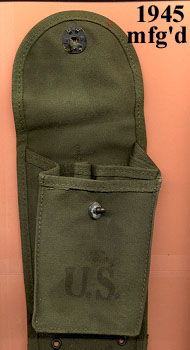
1945 Mfg’d: Undated, note the “UGLY” US marking. This was the sole pouch marked as such, of the 1,500 pouches I got to examine.
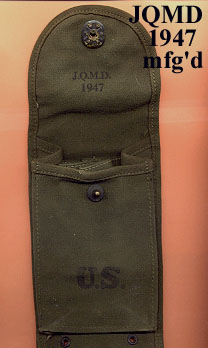
JQMD 1947 (Jeffersonville Quartermaster Depot): This was the earliest dated pouch. I managed to purchase two of these.
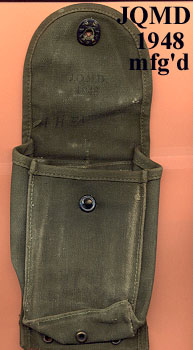
JQMD 1948: Unfortunately this pouch has seen a lot of use. It was the only such pouch in the lot.
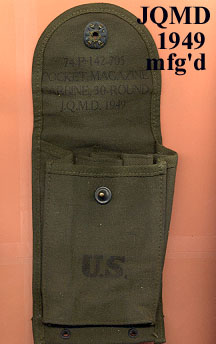
JQMD 1949: I purchased three of these and left a few used ones. Each one of these had been very heavily treated with a Mildew Resistant Treatment, although none are marked that way. It also was the first pouch to carry the Treasury Department’s 1943 mandated catalog system number for procurement, which is a study in itself (74-P-142-705).
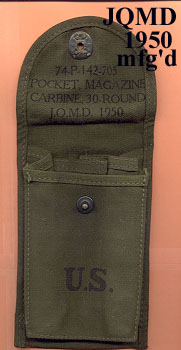
JQMD 1950: Same format and markings as 1949, except for the date. This pouch was very plentiful on the market and in that batch. It does not surprise me that this pouch was REPROED. It was probably the only original pouch the hump artists were able to find. I haven’t seen any in the last year or so, but years ago REPROES were around in heavy numbers. The REPROS had the same markings but were made from lighter canvas and didn’t look or smell like they were 50 years old.
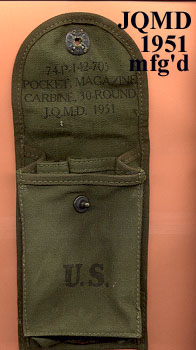
JQMD 1951: Same format and markings, but it was not in the batch. This pouch was purchased at a gun show a few years ago.
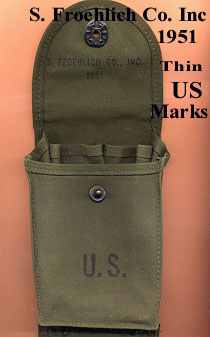
- Froehlich Co., Inc. 1951: S. Froehlich was a manufacturer in New York City. Shortly after purchasing this pouch in 1976, I spent time in the library running down certain contractors. As of that time period the company was still in business producing women’s pocketbooks and purses. There were two different marking formats used in 1951. This pouch has the date below the producer’s name and a very thin US marking.
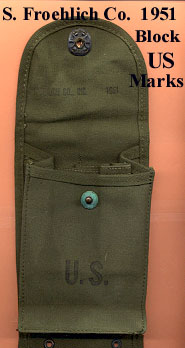
- Froehlich Co., Inc. 1951: Same company but the producer’s name is inline with the date. The US marking is neat block lettering. Different font size was used in company name. This pouch was obtained in a mixed lot of field equipment at a Mechanicsburg, Pennsylvania, DRMO surplus sale.
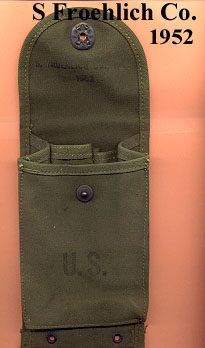
- Froehlich Co., Inc. 1952: Same company, date below producers name, neat block lettering used on US marking. Font size used for company name same as the inline 1951 dated pouch. This was the only such pouch in the batch I inspected.
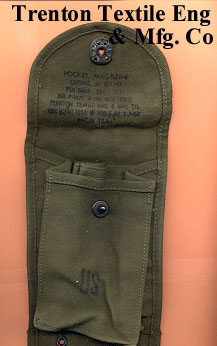
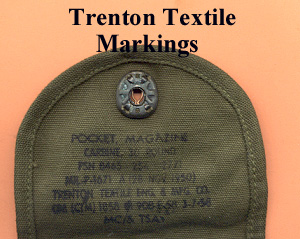
Trenton Textile Eng. & Mfg. Co.: I refer to this as the Trenton Textile pouch. The 1958 marking is a specification date. I would guess this was Vietnam Era production, circa early 1960's. This pouch was the first and only pouch to have the newly adopted Federal Stock Number system as a marking, which became effective in 1957 (8465-254-2771).
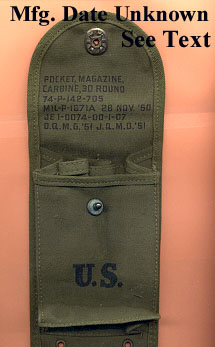
Jointly Engineered: Office of Quartermaster General and Jeffersonville Quartermaster Depot. This pouch is incredibly beautiful in construction and markings. Evidently this pouch reflects the assignment of Military Specification, Mil-P-1671A, in Nov of 1950. The pouch’s markings refer to the joint engineering project of the Quartermaster General and Jeffersonville, or possibly a joint contract. This pouch has no Federal Stock Number markings, so its production period is probably 1954 - 1957. Quite a beauty!!!!
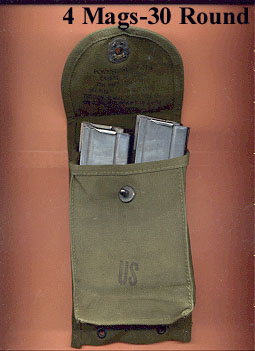
4 Mags –30 Round: Most pouches can be difficult to close with 4 magazines, so some collectors have speculated the pouch is designed for 2 mags in the rear, with the front reserved for storage of stripper clips of ammunition. Others have speculated just the opposite.
Question: What is the availability of US GI 30 round pouches on today's market?
Nobody has bundles of these. When you find them, they have either come out of a collection that recently was liquidated, or they are found one at a time. The auction boards usually have copies, fakes, and fantasy versions (those that never existed). The JQMD 1950 version has been copied to about 95% accuracy. Without an experienced person inspecting it, it will fool mostly everybody in an auction.
Hints on what to look for:
- The magazines were standardized in April of 1945, therefore the 1945 pouch contract probably did not start production until May or June of 1945, at the earliest. At that point in time war production was almost at a halt, therefore all production of this item was in the current Olive Drab (OD). If you see a pouch in Khaki, it is a fake.
- All US GI pouches have a double compartment in the front, and two compartments in the rear. Some fantasy production consisted of one large compartment for all four magazines, and another accommodated only two magazines.
- Know the markings. One pouch was faked with a Federal Stock Number (FSN) and a date of 1952. Unfortunately for the faker, the FSN system did not exist in 1952. Recently the pouch has been changed to include just the FSN and the nomenclature. It is commonly seen on the internet, on auction boards and at gun shows.
- I have been collecting information on these for close to 25 years. I doubt there is a production pouch that is not listed here. So if you see something with markings or characteristics other than shown, be very suspicious.
- Use common sense. When an item is scarce, it is usually quite expensive. Beware of the offers for sale at $9.95, or an endless supply by a merchant. Expect to pay good money for a pouch in good condition.

